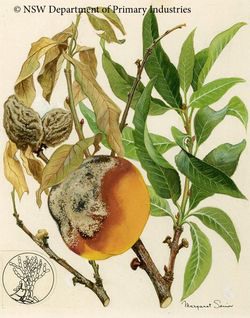 Brown rot caused by Monilinia fructicola (G. Wint) Honey is one of the major postharvest disease of stone fruits. Fruit losses due to this disease are estimated to be 5-10% when fungicides are used, while without fungicides, losses may be more than 50%.
Brown rot caused by Monilinia fructicola (G. Wint) Honey is one of the major postharvest disease of stone fruits. Fruit losses due to this disease are estimated to be 5-10% when fungicides are used, while without fungicides, losses may be more than 50%. Brown rot is a serious disease in California with peaches, nectarines, and plums. Although in the USA fungicides for postharvest application to control decay of peaches and nectarines are registered, there are important reasons to find alternatives to chemical fungicides. For example, the presence of fungicides residues can hinder the export to foreign markets, in the European Union the postharvest application of synthetic fungicides to these fruits is prohibited, ultimately there is a growing demand for fruits coming from organic farming.
Several studies have shown that hot water treatments by themselves or in combination with other control techniques can reduce the postharvest diseases of peaches and nectarines. Treatments of long duration (up to 3 minutes) at relatively low temperatures (from 45 to 52 °C) have been evaluated. But treatments of long duration usually require very big tanks, costs, and space which are the critical issues that have hindered the commercial adoption of hot water treatments. A higher water temperature could reduce the duration of treatment and facilitate the use of smaller tanks, however the efficacy of brief treatments on stone fruit has not been investigated thoroughly.
The objective of the work conducted by Karabulut et al (2010) was to evaluate the efficacy of heated water treatments at relatively high temperatures (24, 50, 55, 60, 65, 70 °C) for short durations (30 or 60 seconds) to control Monilinia fructicola on peach, nectarines, and plums. The treatments efficacy, the incidence, and the severity of lesions caused by fungus were assessed both on fruits after storage at 20°C and 90% RH for 5 days and on fruits after storage at 0°C and 95% RH for 30 days followed by 5 days at 20°C and 90% RH to simulate the commercial marketing conditions. The damage was evaluated using an index from 0 to 3, in which 0, 1, 2, and 3 corresponded to nonexistent, slight, moderate, and severe peel damage, respectively. Fruits with index 2 and 3 were not marketable.
The immersion in water at 60°C for 60 seconds resulted the most effective combination to control the brown rot disease without damaging the fruits. This combination reduced the disease incidence from more than 80% among control fruit to less 2% on plums, from 100% to less than 5% on nectarines stored at 20°C and 90% RH for five days, from 73% to 28% on cold-stored nectarines.
The study demonstrated that water temperature from 55 to 60 °C and a duration treatment from 30 to 60 seconds reduced significantly the incidence of brown rot caused by M. fructicola. The heated water immersion treatments can be combined with other control techniques, such as fungicides, biological agents, and modified atmosphere. Furthermore, this method could be an effective system to manage the postharvest decay of fruits on organic fruit chain.
Original study: Karabulut O.A., Smilanick J.L., Crisosto C.H., Palou L., "Control of brown rot of stone fruits by brief heated water immersion treatments", Crop Protection, Issue No. 29, pagg. 903-906, 2010. For more details: http://ucce.ucdavis.edu/files/datastore/234-1733.pdf









